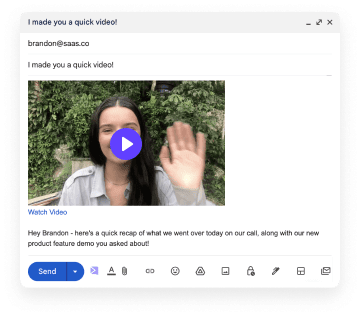A well-designed B2B referral program can be one of the most powerful growth tools in your marketing and sales toolbox. The trust people place in peers far outweighs anything that comes from ads or cold emails. In this guide, we’ll walk through how you can build a B2B referral program that actually drives revenue — not one that just sounds good on paper.
You'll learn how to structure your incentives, leverage your best customers, promote the program without sounding desperate, and use tools like personalized video to make a lasting impression.
Table of Contents
Why B2B Referral Programs Work
B2B sales often involve long deal cycles, high purchase values, and multiple decision-makers. Enter referrals — a game-changer. According to Nielsen, 92% of consumers trust recommendations from people they know. Trust is the currency of B2B, and referrals offer an immediate trust transfer.
Here’s what differentiates B2B referral programs from their B2C counterparts:
- Higher stakes: The average B2B deal size is significantly larger, so one referral can be worth thousands — even millions — of dollars.
- Longer relationships: Retention matters more. Referred clients tend to be more loyal, stay longer, and have a higher lifetime value.
- Professional networks: Business users are part of niche communities — think Slack groups, LinkedIn, mastermind groups — where referrals flow more naturally.
In fact, a study by Influitive found that referred customers have a 16% higher lifetime value and a 37% higher retention rate. The numbers don’t lie — referrals work, and if you’re not actively generating them, you’re leaving money on the table.
How to Design an Incentive Structure that Works
Understand What Motivates Each Party
Stapling a $25 Amazon gift card to a product demo doesn’t work in B2B. You have to think bigger and provide incentives that align with your customer’s goals. Ask yourself:
- What motivates your customers professionally?
- Is the person referring an individual contributor or a decision-maker?
- Would their employer allow them to accept a cash reward?
Offer Two-Sided Rewards
The most successful B2B referral programs reward both the referrer and the referred. Here are a few effective options:

Keep It Simple
Don’t build an incentive program so complicated that nobody participates. The rewards should be easy to understand and easy to redeem. People don’t want to jump through hoops. Consider tools like ReferralCandy or PartnerStack for automation and tracking.
How to Identify Your Best Referrers
Use NPS to Spot Your Brand Advocates
If you’re not measuring customer success and loyalty with Net Promoter Score (NPS), start now. NPS helps you identify your happiest customers, which is where your referral goldmine lies.
Send a quick survey asking, “On a scale of 0 to 10, how likely are you to recommend us?” Anyone scoring 9 or 10 is a Promoter — prime for referrals.
Look at Usage Data and Feature Adoption
Your best referrers often use your product the most. Dive into analytics to identify heavy users. For example, if you’re using Sendspark, look at customers consistently sending personalized videos or using CTA buttons — they’re already finding your product valuable and can talk about it effortlessly.
Don’t Forget Your Internal Champions
In many organizations, the buyer isn’t the daily user. Loop in power users who love your product. Even if they aren’t in a decision-making role, they often have influence over other departments or even external peers.
How to Promote a B2B Referral Program Without Sounding Pushy
No one wants to feel used — especially your best customers. Promote your referral program like a helpful resource, not a sales pitch.
Use Personalized Video Outreach
Here’s where platforms like Sendspark come in clutch. Instead of sending a generic email asking for referrals, record a personalized video thanking a customer for their support and inviting them to join the program.
Here’s a helpful video breaking down how to do this:
This allows you to build emotional connections and increase conversions significantly. For more on how B2B sales teams use video, check out this case study on video sales enablement.
Embed CTAs Across the Product
Your referral program shouldn’t hide in the footer. Embed callouts in your product’s dashboard, onboarding emails, and help center. Even better — nudge users after they perform "wow moments" (e.g., after a successful campaign, completing a task, or reaching a KPI).
Guide users to success, then give them a reason to tell others. Here's how personalized video emails can help here too — they create a magical user moment that’s worth sharing.
Tools to Supercharge Your Referral Program
Here are a few battle-tested tools that help manage and fuel growth from B2B referrals:
- Sendspark: Use AI-powered video intros or templates to automate outreach and encourage referrals with a human touch.
- ReferralHero: A dashboard-driven referral engine with built-in gamification.
- PartnerStack: Ideal for managing referral partners and affiliate tracks at scale.
- Zapier: Automate referral triggers with your CRM or marketing automation tools.
Want to streamline the entire workflow? Here's how to use Sendspark's automated workflows to build personalized referral campaigns that scale.
Real-World Referral Programs That Worked
Dropbox for Teams
Dropbox's team referral program offered 1GB of bonus space for each referral. Though B2C, their business accounts saw rapid growth through IT referrals and group incentives.
Sendspark’s Own Program
Sendspark offers users free video credits or account upgrades for each successful business referral. By combining personalized outreach videos with LinkedIn nudges (see LinkedIn video prospecting), it’s a clean, no-pressure way to drive engagement.
You can sign up for the program here.
Final Thoughts
Referral programs aren’t just for e-commerce brands giving out t-shirts. When done right, they become a sustainable channel for pipelines and trust building in B2B. The key is to connect with your customers on a human level, keep your offer clear, and reward the behavior you want to see more of.
Start by identifying your fans — the users already cheering you on. Delight them. Thank them. Then invite them into a program that makes them feel part of something bigger.
Want to add video to your B2B referral program? Get started with Sendspark today — it's free to try and scales with you.
FAQs
What is a B2B referral program?
A B2B referral program is a structured initiative where current customers refer other businesses in exchange for rewards or incentives.
Do referral programs work in B2B?
Yes — referred B2B leads often convert faster, stay longer, and have higher lifetime value due to the trust factor involved in peer recommendations.
How should I incentivize referrals in a B2B context?
Use two-sided incentives that offer value to both the referrer and the referred. Consider rewards like account credits, donations, or exclusive access.
What tools help manage a B2B referral program?
Popular tools include PartnerStack, ReferralHero, Zapier for automation, and Sendspark for personalized video outreach.




